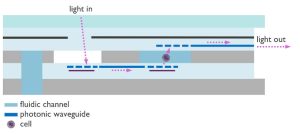
Resolution is sufficient to discriminate between lymphocytes and monocytes, “rivaling the performance of commercial cytometers”, said Imec scientific director Niels Verellen.
It is a flow cytometer and is based on the scattering of a laser beam though a sample. The intensities of forward-scattered light and side-scattered light are measured, and provide information on a cell’s size and granularity respectively (x-y plot below).
Lymphocytes or monocytes can be identified as can the presence of dead or unwanted populations.
The proof-of-concept integrated circuit flow cytometer was fabricated on Imec’s 200mm CMOS pilot line from three wafers.
It has a stack of layers that combine waveguides for cell illumination and scattered light capture, with micro-fluidic channels for cell delivery and cell positioning. Multiple parallel channels are implemented on the same IC.
 Red arrows show fluid flow
Red arrows show fluid flow
The quartz lid supports an SiO2 layer, the latter split by a TiN (black) absorbing layer.
The middle grey layer is the middle wafer, containing fluid channels
The lower wafer has a silicon substrate (grey), through which fluid entry ports are cut, and an SiO2 optical waveguide layer. Gratings (dashed) change light direction.
“Silicon photonics, as demonstrated in this photonic chip, is the building block that merges single-cell detection capabilities with massive parallelisation on a miniaturised footprint,” said Sarcura co-founder and CEO Daniela Buchmayr. “This opens possibilities for addressing previously unsolved challenges in applications such as cell therapy manufacturing.”
 The device is compatible with Imec’s earlier bubble jet cell sorting module, which can be made with wafer-scale fabrication.
The device is compatible with Imec’s earlier bubble jet cell sorting module, which can be made with wafer-scale fabrication.
The next step is to increase capacity to billions of cells, said Imec, which also pointed out that living cells are now being engineered and manufactured as treatments, “notably in ground-breaking therapies like CAR-T immune cell therapy for cancer. The ability to identify these therapeutic cells in complex cell products at high throughput is crucial, and often time sensitive”, it said.
The work has been published in Nature’s Scientific Reports as ‘On-chip flow cytometer using integrated photonics for the detection of human leukocytes‘ – the whole paper can be read without payment.
 Electronics Weekly Electronics Design & Components Tech News
Electronics Weekly Electronics Design & Components Tech News



